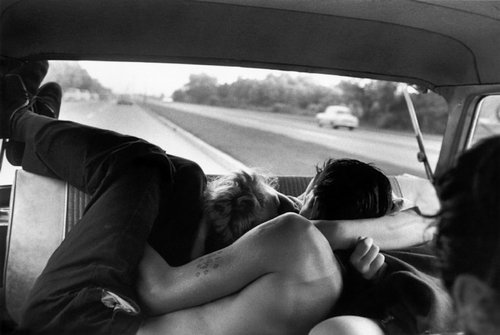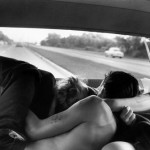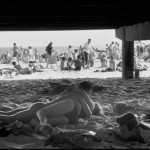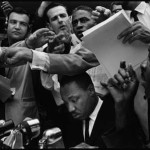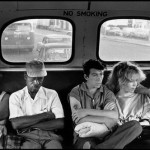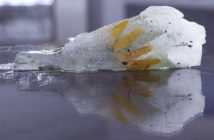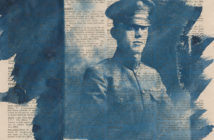So you’ve seen Bruce Davidson's East 100th Street at the Museum of Fine Arts and just can’t help wanting more? That is quite possibly the third of life’s proverbial certainties, and the only one worth indulging. Fortunately, all you have to do is wind your way over to the Robert Klein Gallery and Ars Libri before March 30. The stylish Newbury Street gallery and renowned rare bookdealer have teamed up to present a twofold exhibition of Bruce Davidson’s photographs, 23 in total. Vintage and modern silver gelatin prints from his best-known series, Brooklyn Gang,East 100th Street, and Time of Change, are on view now through Black History Month into the spring. And Witness, as the exhibition is aptly called, is a tribute to the personal sacrifices and sociopolitical strides of the Civil Rights Movement and a reflection on working-class experience, both black and white (and Latino), in the United States throughout the tumultuous sixties.
Like the photo on view at RKG Back of the Bus, in which three members of the eponymous Brooklyn Gang The Jokers sit beside an African-American couple in a segregated bus, Witness bridges with common humanity a racial divide that has not, sadly, even today, quite disappeared. Davidson is a virtuoso of the poignant and humane portrait. But just as the two men, black and white, in his photograph Back of the Bus sit, arms crossed, without touching, so too does Davidson’s work starkly reveal that troubling division.
How could it not? The police officers in his 1963 photograph of the Birmingham Protests who grip a woman protestor by the wrists in front of a movie placard for Damn the Defiant are, after all, white men, figures of high-handed autocracy. Of the thirteen photographs on view at RKG, there is only one portrait of a white, working-class man: a Welsh miner whose face evidences his labor, standing in a doorway holding his unsullied child. Meanwhile, the ten photographs on view at Ars Libri are of members of the Brooklyn Gang, exclusively, all white men and women. I confess I was initially puzzled by the curatorial decision to separate Davidson’s series in this way. But doing so, I now believe, is reflective of the deeply divided, lived experiences of race in 1960s America to which his photography bears witness. That is not what draws me to Davidson’s work, personally, but I can appreciate the approach.
A portrait of Martin Luther King, Jr., solemn amongst a bustling throng at a press conference, greeted us in the entrance to the Robert Klein Gallery--just before the gallery attendant, seated at a desk behind us, had the opportunity. I was struck by the clock with no hands and empty bulletin in Child at Blackboard in a Schoolroom; the room itself, in Selma, appears empty, too, its ill-sized "door" (labeled as such) askew in the frame, its foundation unbalanced. Or by the little girl in dress and sandals brushing the hair of her white, naked doll on the porch; Girl with Doll has scraped her knee, which rests upon a similarly abraded metal chair where she sits, tilting her head to the side gently. As in much of Davidson’s work, there are families, children, friends and couples in these photographs. Perhaps, most prominently in Witness, there are couples: embracing, dancing, and suggestively kissing in darkened rooms, barely visible to the camera. That is true of both the work at RKG and Ars Libri, and is of more interest to me than the visual and spatial separation of photographic bodies in Witness.
Even the arrangement of prints at Ars Libri lends itself to this interpretation, with photographs appearing in pairs along the wall. We see women doing up their hair with bobby pins, James Dean-type young men, Coca-Cola advertisements, and classic diner scenes, and no less than six couples, in quiet or passionate embraces. The eye moves gracefully from one print to the next, following the shapes of bodies and gestures; outstretched arms and hands, especially, orchestrate this natural movement. It’s almost like watching a dance unfold. And it is a decidedly working-class ballet, with counterparts at RKG in jukeboxes and couples holding each other close.
This thread of humanity is what ties Davidson’s work together, and it is what keeps me returning to his photographs, always, for one more look. Not without sociopolitical bite or gravity, Witness is a testament to human struggle that does not forget beauty, still moments, or, perhaps most importantly, love. Here we see the fight for civil and human rights, and, beyond that, the human connections and dignity for which we fight in the first place.
This month is the perfect time to bear your own witness to Witness, on view now through March 30 at RKG on Newbury and Ars Libri at 500 Harrison. It’s well worth the walk.
- Bruce Davidson Brooklyn Gang (Lefty and Girl in Backseat), New York, 1959 Courtesy of Robert Klein Gallery
- Bruce Davidson Brooklyn Gang (Couple Entwined Under Boardwalk), New York, 1959 Courtesy of Robert Klein Gallery
- Bruce Davidson East 100th Street (Family on Sidewalk), Harlem, New York, 1966-1968 Courtesy of Robert Klein Gallery 9 1/8 x 6 7/8 inch vintage gelatin silver print
- Bruce Davidson Time of Change (Dr. Martin Luther King, Jr., at a Press Conference) in Birmingham, Alabama, 1963 Courtesy of Robert Klein Gallery
- Bruce Davidson Brooklyn Gang (Back of the Bus), New York, 1959 Courtesy of Robert Klein Gallery

